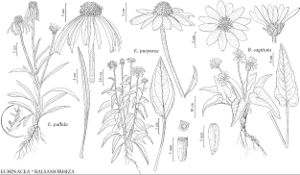Echinacea purpurea
Methodus, 591. 1794.
Plants 50–120 cm (roots fibrous). Herbage usually hairy (hairs spreading to ascending, to 2 mm), sometimes glabrous. Stems usually brownish green. Basal leaves: petioles 0–17 (–25) cm; blades 3-nerved or 5-nerved, ovate to narrowly lanceolate, 5–30 × (1–) 5–12 cm, bases usually rounded to cordate, margins usually serrate to dentate, rarely entire. Peduncles 8–25 cm. Phyllaries linear to lanceolate, 8–17 × 1–8 mm. Receptacles: paleae 9–15 mm, tips red-orange, straight or slightly curved, sharp-pointed. Ray corollas pink to purple, laminae spreading to recurved, 30–80 × 7–19 mm, sparsely hairy abaxially. Discs conic, 14–45 × 20–40 mm. Disc corollas 4.5–5.7 mm, lobes greenish to pink or purple. Cypselae off-white, 3.5–5 mm, usually glabrous (ray cypselae sometimes hairy on angles); pappi ca. 1.2 mm (teeth equal). 2n = 22.
Phenology: Flowering late spring–summer.
Habitat: Rocky, open woods, thickets, prairies, especially near waterways
Elevation: 10–400+ m
Distribution

Ont., Ala., Ark., Fla., Ga., Ill., Ind., Iowa, Kans., Ky., La., Miss., Mo., N.C., Ohio, Okla., Tenn., Tex., Wis.
Discussion
Echinacea purpurea is introduced in Ontario. It and cultivars derived from it are extensively grown ornamentals in gardens, wildflower roadside plantings, and prairie restoration sites. Because of its popularity as an herbal remedy, it is also grown commercially. As a result of such activities, naturalized and persisting populations may extend the natural range of E. purpurea. Selections used for such plantings may differ from native forms.
Selected References
None.
Lower Taxa
"broader" is not a number.
